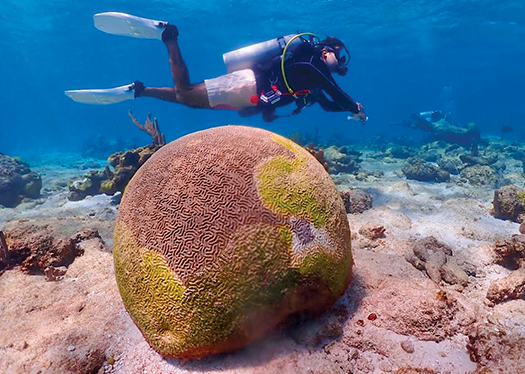
Brain coral affected by tissue-loss disease. (Photo courtesy of U.S. National Park Service and NOAA)
A deadly disease infecting coral reefs in the Caribbean has continued to spread through the region as scientists ramp up efforts to use new tools to understand the outbreak and contain its rapid progression.
Stony coral tissue-loss disease is spreading south from Saint Kitts & Nevis and Dominica, where it was found last year, and from Honduras in Central America. It was confirmed this year to have reached Grenada, Saint Vincent and the Grenadines, and San Andrés, an island belonging to Colombia off the coast of Nicaragua.
The disease has now been identified in 25 Caribbean Basin countries and territories in all, alarming researchers and stoking fears it will jump to the Pacific.
In response, the National Oceanic and Atmospheric Administration (NOAA) this month released a response plan that outlines diagnostic and treatment methods, recommends funding to help determine the disease’s still-unknown cause, and seeks to prepare communities for its arrival.
“Stony coral tissue-loss disease is a potential global threat,” Jennifer Koss, director of the NOAA Coral Reef Conservation Program, said in a recent press conference. “This may be the most lethal coral disease ever reported. The key to this plan is preventing the spread into the Pacific and saving an enormous amount of corals while also getting better at preventing further spread in the Caribbean.”
First identified along the shores of south Florida in 2014, the disease infects at least 22 species of hard coral that form the building blocks of reefs, destroying soft tissue and causing it to flake off. The disease can kill a coral colony within weeks.
Researchers have found that applying an antibiotic paste to infected corals can help treat it, leading some to believe the illness has a bacterial component, Koss said. (See "Region’s stony corals face pandemic of their own" —EcoAméricas, March 2021.) Environmental stressors such as water pollution, climate change, overfishing, and waterborne viruses may also play a role, she added.
Ship traffic eyed
Scientists hypothesize that ballast water from ships may be a vector, so they are working to identify high risk locations, especially near ports, and trying to make the shipping industry aware of the issue.
The U.S. Coast Guard, for its part, has increased checks of high-risk vessels, paying particular attention to ships traveling between the Caribbean and the Pacific, says Caroline McLaughlin, national coral disease coordinator of the University of Florida’s Sea Grant Program. Additionally, the U.S. Environmental Protection Agency is updating regulations on ballast water discharge.
“There’s ongoing coordination with the shipping industry to disseminate and continue to communicate those best practices for preventing disease spread,” she said. “There’s a focus on building partnerships for ballast water management with regional and international organizations and updating existing ballast water best-management practices as soon as we get results from ongoing research projects.”
Eradicating the disease completely is unlikely at this point, researchers say. In Florida, scientists are starting to see some level of resistance to the disease in reefs where outbreaks previously occurred and are now shifting to a rescue and restoration phase, a sign of what the future may hold for countries dealing with ongoing outbreaks.
“In Florida where it was first identified, it has really become endemic along reefs, so there is a transition from emergency management to kind of looking at questions such as, ‘How are we going to deal with the impact of this disease and its continued presence on reefs longer term?’” says McLaughlin. “In the U.S. Caribbean, Puerto Rico and the Virgin Islands, the disease has only more recently arrived, so they’re still dealing with some of these outbreak situations on the reefs where the disease is rampant and mortality levels are really high.”
In Colombia, the environment ministry has issued a series of recommendations for dealing with the outbreak. There, the disease has infected corals in the Seaflower Biosphere Reserve on San Andrés Island, a Unesco site that hosts over 100 species of soft and hard coral as well as hundreds of fish species.
Colombia reaching out
To protect its reefs, Colombia is working with local universities as well as local and international nongovernmental organizations such as the Perry Institute, a U.S.-based nonprofit focused on marine science in the Caribbean.
NOAA seeks to promote such collaboration by convening reef managers from across the Caribbean and using its own and private-partner funding to support coral-disease research and implementation of its plan.
In Dominica, a nongovernmental group called Resilient Dominica (REZDM), has been treating stony corals affected there since 2021. Sustainable Grenadines, a Saint Vincent and the Grenadines-based organization, has worked with the Atlantic and Gulf Rapid Reef Assessment (Agrra), a network of scientists focused on reef protection, to monitor susceptible species throughout the archipelago.
In Florida, researchers have collected samples of corals that survived the outbreak and are starting to reproduce them. The spawned corals that have reached juvenile age are showing signs of resistance, according to Andy Bruckner, research coordinator at NOAA’s Florida Keys National Marine Sanctuary.
It is unclear if the surviving corals had some sort of immune response or if they were just more resilient to begin with, he says, but the hope is to be able to restore the reef with more resistant species less susceptible to stony coral tissue-loss disease in the future.
“What we’re doing is trying to improve the overall resilience of the ecosystem,” Bruckner says. “Ultimately, this shows that by understanding some of this, that can have much more of a successful effect in our intervention.”
- Michael McDonald
NOAA strategy for stony coral tissue-loss disease: link